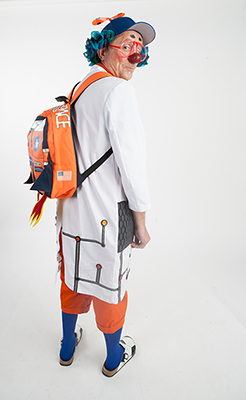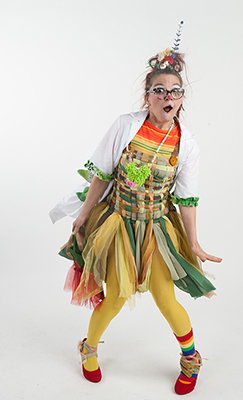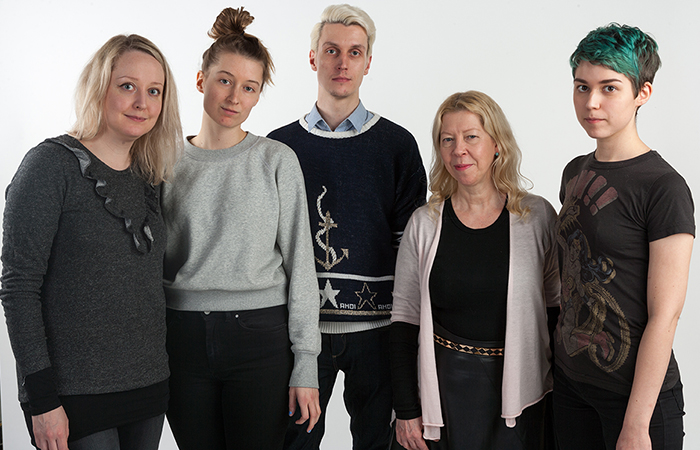Hospital clowns’ new costumes made at Aalto
36 new hospital clown costumes were created in the collaboration project of Costume Design and the Finnish Hospital Clowns Association.

 Lecturer Merja Väisänen lead the students Tiina Hauta-aho, Joona Huotari, Mimosa Kuusimäki and Vilma Väisänen to renew the hospital clowns’ wardrobe. The idea was to elevate the status of the profession and to unify the clowns’ work clothing and performance costume. At the same time, they aimed at maintaining and clarifying the identity each clown has created for their own character.
Lecturer Merja Väisänen lead the students Tiina Hauta-aho, Joona Huotari, Mimosa Kuusimäki and Vilma Väisänen to renew the hospital clowns’ wardrobe. The idea was to elevate the status of the profession and to unify the clowns’ work clothing and performance costume. At the same time, they aimed at maintaining and clarifying the identity each clown has created for their own character.
The clowns’ use of doctor’s white coats and using print textiles donated by Marimekko as the outfits’ material unified the look of the outfits.
‘Marimekko gave us surplus textiles, so we had to make do with the amount of material and the prints we were given. This was actually quite a nice marginal and each designer got to choose the prints that attracted them the most. As an end result, the Marimekko textiles brought a modern look to the ensemble’, tells Merja Väisänen.
The costume of each clown consists of 5–9 pieces, so altogether 250 different pieces of hospital clown outfits were designed in the project.
The stage costume for a performing artist forms a medium through which a person steps into the role of a performer. The stage costume support the role and allow the performer to act as the role demands.
The work was made thoroughly and in collaboration with the artists. Various conditions related to the hospital environment had to be taken into account when designing the outfits. For example, hygiene-related factors had to be carefully acknowledged’, says Merja Väisänen.
‘We also gave a good thought on how to make the costume more functional. This was realised by adding more pockets to the doctor’s coats to fit all the soap bubble tubes, magic books, harmonicas and all the items the clown doctors may need in their work.’
The characters were brought to life

The design project is a fine example of how the interaction between the students and the teacher can be realised at its best through common artistic work. When the teacher and the students work together as equal colleagues, the sharing of know-how and the constant learning of new things through collaboration will be enabled.
‘The more I presented the topic to the work group, the more my personal inner designer-artist started to stir and think ideas up,’ tells Merja Väisänen.
This was also noticed by the work group. They felt that it would be pleasant to have Väisänen participate also as a designer. She also acted as the project's artistic director creating the general outlines and marginals for the design process, so that the work of five designers could be turned into a single ensemble.
‘Now the costumes are ready and already in the clowns’ use. It was a great moment when the clowns wore their new costumes for the first time and the characters were brought to life! However, the project is not at end. Instead, the clowns need new costumes in future, as well. Now we have to decide how the story will continue.’
The project gained funding from the Finnish Culture Foundation. Most of the costumes were created in the premises of Sankariliiga, which is a film and stage industry Art Department enterprise founded by costume designers and production designers who have graduated from Aalto University. Designer Tiina Hauta-aho realised her master’s thesis work through the project, and the nine clown costumes that were a part of her thesis were made at the Aalto University Costume Design Costume Studio.
Hospital clown activity will have been organised for 15 years in Finland this February. The art form based on interaction and being present has become an established part of Finnish hospitals’ paediatric units’ routines. Worldwide, the hospital clown activity turned 30 years last year, and it was celebrated by 300 hospital clowns from all around the world in Lisbon. The group of professionals who fool around in a demanding environment is growing, developing and organising for the benefit of the children all around the globe.
Clown Hoppson in the upper picture on the right and TaijaKaijaKotKot on the left. Designers in the group photo: Tiina Hauta-aho, Mimosa Kuusimäki, Joona Huotari, Merja Väisänen and Vilma Väisänen. Photos: Sairaalaklovnit / Juuso Partti.



